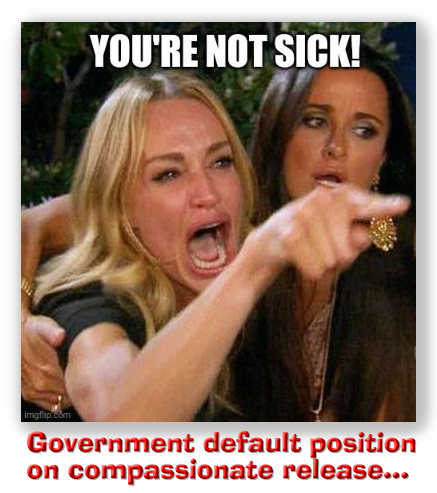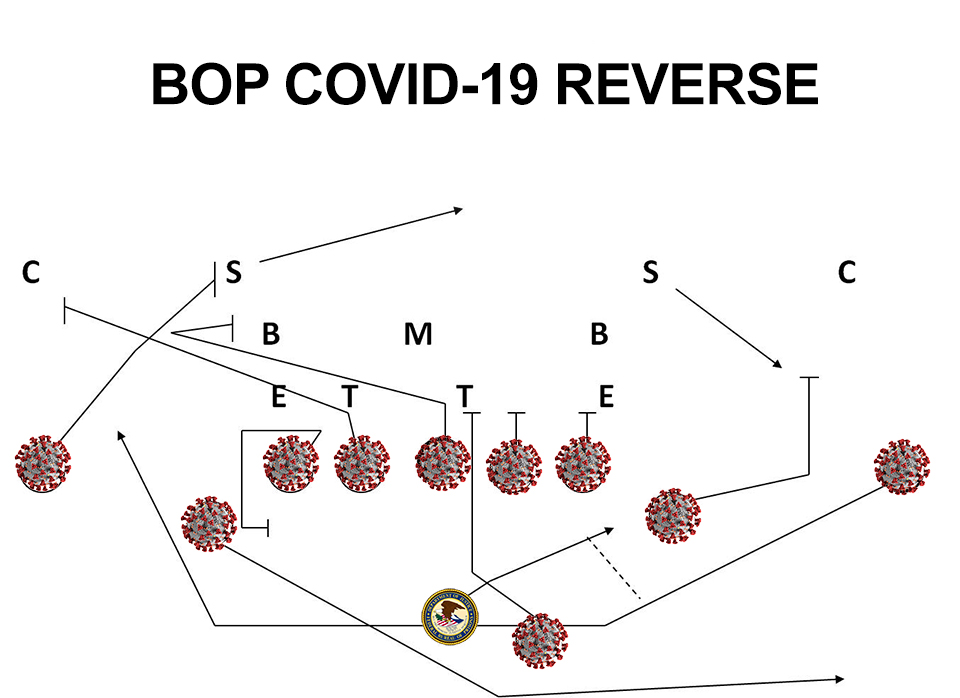We post news and comment on federal criminal justice issues, focused primarily on trial and post-conviction matters, legislative initiatives, and sentencing issues.

BOP DIRECTOR TO BE GRILLED ABOUT COVID, FIRST STEP
 Almost every inmate in the Bureau of Prisons system looks forward to Wednesdays, when the nationwide lunch menu serves sandwiches that pass for hamburgers, with a side of fries. But this week, BOP Director Michael Carvajal’s hamburger day may come one day later.
Almost every inmate in the Bureau of Prisons system looks forward to Wednesdays, when the nationwide lunch menu serves sandwiches that pass for hamburgers, with a side of fries. But this week, BOP Director Michael Carvajal’s hamburger day may come one day later.
Carvajal will testify this Thursday before the full Senate Judiciary Committee in the first comprehensive BOP oversight hearing since 2019. Politico said last week that principal issues will include how BOP has handled the coronavirus pandemic and how it has implemented the First Step Act. “On both counts,” Politico reported, “the Bureau has drawn bipartisan criticism.”
A BOP statement last week said Director Carvajal “is looking forward to the opportunity to provide the Senate Judiciary Committee with information at the upcoming Oversight of the Federal Bureau of Prisons hearing on the morning of April 15, 2021.” Yeah, I have no doubt of that… like a dental patient eagerly anticipates a root canal without Novocain.
 At the hearing, Carvajal will face Sen. Richard Durbin (D-Illinois) — now the committee chair — former chairman Charles Grassley (R-Iowa), Patrick Leahy (D-Vermont), John Cornyn (R-Texas), Cory Booker (D-New Jersey and Mike Lee (R-Utah), among others. Durbin, Grassley, Leahy, and Lee have been vigorous in their demands that the BOP should do more to move the most vulnerable inmates out of prison because of COVID-19. And Booker is a co-sponsor of the Federal Correctional Facilities COVID-19 Response Act, introduced two months ago to address inadequacies in the BOP’s management of the pandemic. “The Department of Justice’ response to the COVID-19 pandemic has been unacceptable and has placed nearly 2.3 million incarcerated people in danger,” Booker said at the time.
At the hearing, Carvajal will face Sen. Richard Durbin (D-Illinois) — now the committee chair — former chairman Charles Grassley (R-Iowa), Patrick Leahy (D-Vermont), John Cornyn (R-Texas), Cory Booker (D-New Jersey and Mike Lee (R-Utah), among others. Durbin, Grassley, Leahy, and Lee have been vigorous in their demands that the BOP should do more to move the most vulnerable inmates out of prison because of COVID-19. And Booker is a co-sponsor of the Federal Correctional Facilities COVID-19 Response Act, introduced two months ago to address inadequacies in the BOP’s management of the pandemic. “The Department of Justice’ response to the COVID-19 pandemic has been unacceptable and has placed nearly 2.3 million incarcerated people in danger,” Booker said at the time.
What will the Committee ask Carvajal? Well, it could start with the Director’s past statements about the BOP’s “transparency” on COVID. Carvajal told a House subcommittee in December that “the Bureau has published one of the most detailed and thorough COVID pandemic resource areas in the federal government on our public website at www.bop.gov/coronavirus.”
 Is that a fact, Mr. Director? Sure, since April 2020, the BOP has provided a running total of the number of inmates who tested positive for COVID. But two months ago, the total mysteriously started going down. I initially thought that Steven Hawking had been right that the universe may someday contract: maybe it has begun, and time is moving backward. But that was not the case. Instead, the BOP had adopted the view is that if an inmate contracted COVID but thereafter was released, it should be treated as though he or she had never been there. Because the inmate had never been there, then his or her COVID case could not count against the BOP’s total.
Is that a fact, Mr. Director? Sure, since April 2020, the BOP has provided a running total of the number of inmates who tested positive for COVID. But two months ago, the total mysteriously started going down. I initially thought that Steven Hawking had been right that the universe may someday contract: maybe it has begun, and time is moving backward. But that was not the case. Instead, the BOP had adopted the view is that if an inmate contracted COVID but thereafter was released, it should be treated as though he or she had never been there. Because the inmate had never been there, then his or her COVID case could not count against the BOP’s total.
Accounting brilliance, Mr. Director! But don’t be surprised if some on the Committee might be so forward-thinking, number-wise, and wonder whether – with enough time – the Bureau’s total number of historic COVID cases might regress to zero.
What’s more, the Bureau’s loose use of the definition of “recovered” might raise Committee doubts. Last week, the BOP announced that two more “recovered” inmates, both at the Springfield, Missouri, Medical Center for Federal Inmates, had died. One, Leonard Williams, contracted COVID in late February, but “on Monday, March 22, 2021,” the BOP said, “in accordance with Centers for Disease Control and Prevention (CDC) guidelines, Mr. Williams was converted to a status of recovered following the completion of medical isolation and presenting with no symptoms. On Saturday, April 3, 2021, Mr. Williams became unresponsive.” He was pretty unresponsive, all right. The EMT crew pronounced him dead before he got to the hospital.
Another inmate, Jaime Benavides, caught COVID in December but was declared “recovered” 10 days later. But “on Thursday, March 25, 2021, Mr. Benavides’ condition worsened and he was transported to a local hospital for further treatment and evaluation.” Committee members may how a “recovered” person’s condition can worsen. After all, he had “recovered!” Mr. Benavides died of his recovery on April 4.
 The Marshall Project has been reporting a tally of COVID in federal and state prisons every Friday for over a year. Last Friday, it informed readers that its
The Marshall Project has been reporting a tally of COVID in federal and state prisons every Friday for over a year. Last Friday, it informed readers that its
data no longer includes new cases from the Federal Bureau of Prisons, which has had more prisoners infected than any other system. In early March, the bureau’s totals began to drop because they removed cases of anyone who was released, a spokesman said. Similarly, in early April, the Bureau of Prisons lowered the number of deaths it was reporting among people held in private prisons. As a result, we cannot accurately determine new infections or deaths in federal prisons.
The New York Times noted last week in a report on COVID in prisons that its data were not complete because “the federal prison system and ICE did not regularly provide facility-level data for inmate infections or disclose the number of tests conducted on inmates or correctional staff members.”
Maybe the Committee will ask Carvajal about the BOP’s abysmal staff vaccination rate. Last week, the Federal News Network reported on a number of government agencies whose frontline workers were having trouble accessing vaccines. But, FNN said, “the Bureau of Prisons in the Justice Department is having the opposite problem. BOP says it offered the COVID-19 vaccine to all of its employees, but only 49% took the agency up on its offer. BOP says it can’t require employees to take the vaccine since the Food and Drug Administration hasn’t formally approved them yet.”
As of last Friday, the BOP reported only a very questionable 208 inmate COVID cases, but 1,250 sick staff, a number unchanged in the last two weeks. Committee members might justifiably wonder why the inmate number – which the BOP controls – has dropped so dramatically, while the staff number – which the BOP cannot control – remains so high.
Perhaps the Committee will want to know why the BOP touts that it had put 125,000 shots into arms as of last Friday, yet it reports only 23% of the inmate population has been vaccinated.
 But it may just be that the Committee will be interested in some stats The New York Times ran in last week’s COVID in prisons story: Worldwide, two people out of 100 caught COVID. In the US, nine people out of 100 caught COVID. In the BOP, 39 out of 100 prisoners, although the “true count is most likely higher because of a dearth of testing.”
But it may just be that the Committee will be interested in some stats The New York Times ran in last week’s COVID in prisons story: Worldwide, two people out of 100 caught COVID. In the US, nine people out of 100 caught COVID. In the BOP, 39 out of 100 prisoners, although the “true count is most likely higher because of a dearth of testing.”
There’s more than Monday-morning quarterbacking to this hearing. The pandemic is not quite done. Researchers are warning that if the B.1.1.7 variant, which is more contagious, becomes more dominant, the nation could experience another peak in cases this summer that may be worse than the January peak.
It is likely that Thursday will be hamburger day for the Director. After all, Politico says he will be “grilled.”
Senate Judiciary Committee Calendar, Oversight of the Federal Bureau of Prisons
Politico, Prison chief to face congressional grilling (April 9, 2021)
S.328, Federal Correctional Facilities COVID–19 Response Act
DOJ, Statement of Michael D. Carvajal, Director Federal Bureau of Prisons (December 2, 2020)
BOP Press Release, Inmate Death at MCFP Springfield (April 7, 2021)
BOP Press Release No. 2, Inmate Death at MCFP Springfield (April 7, 2021)
The Marshall Project, A State-by-State Look at Coronavirus in Prisons (April 9, 2021)
FNN, Frontline feds facing inconsistent access to COVID vaccines (April 6, 2021)
The New York Times, Incarcerated and Infected: How the Virus Tore Through the US Prison System (April 10, 2021)
Insidenova, Spread of new COVID-19 variant may cause another peak in cases this summer, UVa researchers say (April 4, 2021)
– Thomas L. Root






















